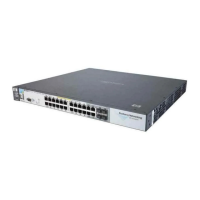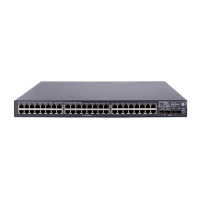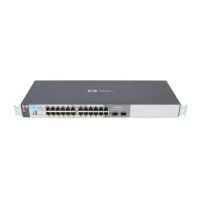8
Figure 1. ProVision ASIC architecture for HP ProCurve Switch 5406zl
For some customers, the Layer 3 features and redundant power supply features of the HP ProCurve Switch
5400zl series also make it well-suited as a distribution switch. New to the 5400zl and 3500 series is the
optional deployment of a Premium License feature group as opposed to the standard offerings of the Intelligent
Edge feature group. The Premium License contains all of the Intelligent Edge features plus additional features
oriented towards routing that are useful when deploying the switch at the distribution level of the network. The
Premium License feature group includes protocols such as PIM-SM, PIM-DM, OSPF-ECMP, and VRRP.
HP ProCurve Switch 6200yl-24G-mGBIC
The HP ProCurve Switch 6200yl-24G-mGBIC is an advanced Layer 3 stackable at 1U height. It has 24 mini-
GBIC slots and an expansion slot for an optional 4-port 10-GbE module. Designed to be deployed as an
aggregator of traffic from the edge to the core of the network, this switch supports a variety of Gigabit mini-
GBICs, such as SX, LX, LH, and 1000Base-T. The Premium License feature group is standard on the
HP ProCurve Switch 6200yl-24G-mGBIC.
Like the 5400zl and 3500 series switches, the foundation for this switch is a purpose-built ProVision ASIC that
allows the most demanding networking features, such as QoS and security, to be implemented in a scalable
yet granular fashion. With its high-performance architecture, 10-GbE capability, and programmable ASIC, this
switch offers excellent investment protection, flexibility, and scalability.
ProVision ASIC architecture
The ProVision application-specific integrated circuit (ASIC) architecture is the latest-generation HP ProCurve
ASIC technology and is used in the HP ProCurve Switch 8200zl, 5400zl, 3500, and 6200yl series. The
ProVision ASIC architecture consists of multiple network chips interconnected by an active crossbar consisting
of the fabric chip. A network chip is implemented on each of the various line interface modules (also known
as line cards). The fabric chip is integrated on the switch backplane, which helps reduce the overall size of the
switch.
Each network chip represents a node in the system with “links” connecting to the interconnect fabric. Each link
provides approximately 28.8 Gbps of data bandwidth. In addition, a management module with a dedicated
CPU provides communications control between the network chips and fabric chips.

